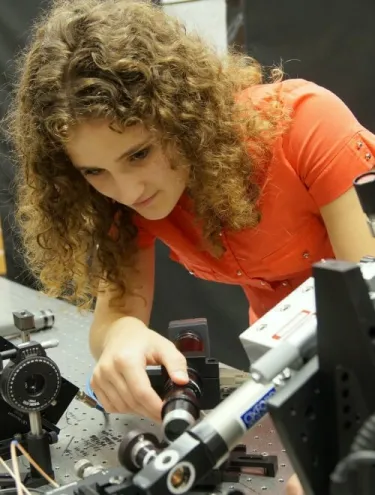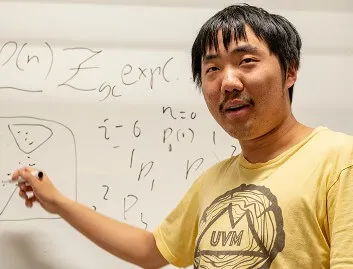It’s not uncommon for undergraduate students to publish their research in professional peer-reviewed scientific journals. Faculty researchers can apply for additional funds to support undergraduates in their labs. In addition, the department awards students from the A. Crowell Fund to support undergraduate research in physics.

Hands-on Research Opportunities
Physics research faculty have open projects that feature opportunities for undergraduate research. Interested students are strongly encouraged to explore research interests and opportunities through discussions with professors and fellow students in the department.
Learn about faculty research interestsResearch Opportunities
Biophysics
Our biophysics research focuses on developing advanced theoretical and computational methods to study biological processes across a wide range of spatial and time scales. At the molecular and intracellular levels, we investigate the structure and dynamics of biological macromolecules and protein-drug interactions. On the cellular and tissue scales, we explore the properties and dynamics of tissues and tumors as living soft materials. Our work contributes to the design of new medicines and bio-inspired materials aimed at improving human health. Another area of our computational research is the application of deep learning methods in biology.
Faculty: Wen Ma, Haicen Yue
Theoretical Condensed Matter Physics
Our research in theoretical condensed matter is concerned with high-temperature superconductivity, magnetism, quantum sticking, density functional theory, correlated electron systems and the properties of Graphenes, Fullerenes and nanotubes.
Faculty: Dennis Clougherty, Valeri Kotov
Experimental Materials Physics
Our research in experimental materials physics includes hybrid and organic photovoltaic device physics, thin film deposition and growth, solid state ionics and surface science, with broad application in low-cost and high-performance photovoltaics, next-generation computing, sensors, and electrochemical systems.
Faculty: Matthew Dawber, Randall Headrick, Alexander C. Kozen, Matthew White
Examples of Student Research in Physics
Katy Czar Researchers Thin-Film Organic Semiconductors

Katy Czar '19 has been a physics enthusiast since the sixth grade. She was a serial watcher of NOVA episodes, and read anything she could find about CERN, home of the Large Hadron Collider in Europe that recreates conditions of the first moments of the universe. She received her B.S. degree in physics from UVM in May, along with the department’s Albert D. Crowell Award, presented annually to a senior physics major for outstanding undergraduate research. Czar credits this experience as a key credential in getting a job as technical consultant for at Galen Healthcare Solutions which begins a few weeks after graduation.
A Vermont native, Czar envisioned herself going to a college out of state. But she was captivated by the UVM campus on her first visit. “I just loved the feel of the place. It turned out to be the right decision.”
She hadn’t taken physics in high school, though she completed the International Baccalaureate program at The Long Trail School, a regimen she describes as “AP’s on steroids.” University level physics challenged her analytical skills and natural enthusiasm for the discipline. Grit and determination helped her mount the learning curve.
“I got a ‘C’ on my first test,” she remembers. “I spent every week in office hours and ended up getting an ‘A’ in the class.” She also discovered a supportive and accessible group of teacher/scholars.
“Faculty in the physics department are fantastic people,” she said. “They have set office hours but often they’ll say ‘just stop by anytime.’ It’s a really close-knit department where you get to know your professors and fellow students.”
The instructor of her first physics class, Associate Professor Madalina Furis, took high-achieving students in the class out for coffee—she urged them to get involved in research by their sophomore year. Czar had been attracted to Furis’ lab from her very first UVM tour. “Honestly, the lasers really drew me in,” Czar remembers. Furis agreed to take Czar on as a research advisee.
“In her lab we do spectroscopy of organic thin-film semiconductors,” Czar says of her work. “We use lasers to investigate the behavior of electrons.” She explains that inorganic semiconductors with silicon as the main ingredient are already present in electronic devices including LED screens and cellphones. Czar says organic semiconductors offer a more environmentally friendly alternative—they can be deposited on flexible substrates like plastics or foils.
“The challenge is they are not as efficient at moving electrons as silicon and other inorganic semiconductors,” Czar says. “Our goal is finding ways to fine tune these materials to achieve better performance efficiencies.”
Besides being more environmentally sound, the organic versions of the semiconductors would be cheaper to produce. It could result in products like flexible LEDs (think of a cellphone screen that can folded up like a wallet) or bio sensors that can be attached to and move with the human body.
Undergrad Jiangyong Yu Invents Algorithm to Measure Temperature of Super Cool Atoms

When you want to know the temperature inside your refrigerator, you can just open the door and stick in a thermometer. Physicists who study tiny collections of ultra-cold atoms don’t have it so easy. Undergrad Jiangyong Yu ‘19 has helped invent a new tool—“it’s an algorithm,” he says—that promises to give experimental scientists a better measure of what’s happening inside some of the most interesting and strange collections of matter known to science—atoms near absolute zero.
For example, researchers might have a known number of lithium atoms trapped in a microscopic box that’s so cold that none of the atoms can get out. Really crazy (um, cool?) realities of physics have been discovered studying these kinds of systems. But measuring the thermodynamics inside the box—including, critically, the temperature—has been “very difficult,” says professor Adrian Del Maestro. He and UVM post-doctoral researcher Hatem Barghathi worked side-by-side with Yu on a new approach to what are called “canonical partition functions.” By combining ideas from pure mathematics with well-established formulas used to study real-world quantum gases, the team was able to tame a long-standing mathematical problem in physics.
Jiangyong Yu’s theoretical research was so original and useful that he was invited to give a talk last month at the most prestigious physics meeting in the country. Being a college student speaking to a roomful of professors at the American Physical Society was daunting. “There's 60 experts in the room and we thought someone might stand up and say, ‘you know, actually this was known in 1972,’ but nobody did,” said Del Maestro. “People liked it,” said Yu, a physics major with a double minor in computer science and music. The UVM team, using the university’s VACC supercomputer and with support from the National Science Foundation, seems to have discovered a new way to build a more accurate thermometer for a quantum-scale icebox. “Who knows what we’ll find,” says Del Maestro. “Maybe some entirely new physics.”
Research Interests Lead to Graduate Program at Johns Hopkins

Henry Mitchell’s interests span many worlds. The math and physics major has done research with five different professors in three different departments (one of which resulted in a published paper). How? “Just knock on doors. Go places and introduce yourself,” says Mitchell. He met Larner College of Medicine faculty member Matt Mahoney, whose work on epilepsy focuses on statistical analysis of neural activity. Mitchell’s honor’s thesis is investigating a link between those odd chimera states and patterns observed in neural models. Someday, the research could be used to better understand how seizures arise and spread in the brain. Reflecting back on the research and exploration he’s done in his four years here, “knowing that those opportunities were available was a huge part of why I ended up coming to UVM.” He dove into campus life, too – playing intramural soccer, DJing at WRUV, tutoring peers, and giving campus tours as an AdvoCat. Next up: Johns Hopkins for a post-baccalaureate pre-med program. An internship at Goddard Space Flight Center last summer cemented his hopes of someday seeing outer space. “I would love to be a NASA flight surgeon.”